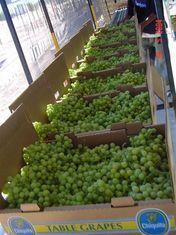
Mexico may be famous for its avocados but, in the future, grapes could also step into the limelight if shippers have their way. In recent years, supporters of the Mexican grape industry say growers are making important improvements in all aspects of their operations in an effort to keep up with world leading producers.
“Mexico is progressing in all manners of infrastructure, from temperature control to transportation innovations, as well as developing with manufacturers the kind of packaging the UK market demands,” claims AALPUM’s Cesar Salazar Platt.
Quality wise, Miguel Suarez of the Fresh Produce Association of the Americas believes that Mexican grapes are recognised as a superior quality product, but the sector still faces challenges.
“I think that keeping cost efficient and at the same time achieving good yields of top quality fruit will be the biggest challenge for growers,” he continues. “Unfortunately, I think that profitability and economics are becoming more the deciding factor that determines movement of fruit around the world.”
Grapes are grown in Mexico’s northwest region and exporters ship in May, normally in the middle of the month. Volumes peak in mid-June.
Platt notes that growers are looking to extend their season and supply grapes in late April and early July. “Mexico enjoys a strategic position in spring grape production for the northern hemisphere markets when the southern hemisphere season draws to a close, and before significant volumes can be produced in the Mediterranean and Middle Eastern countries,” he says.
The seedless varieties Perlette, Flame and Sugraone are exported to the UK and marketers don’t believe there will be significant varietal change in the near future.
“The Crimson variety is not grown much in this area, and Red Globe, which is increasing in acreage, is a seeded variety and there isn’t much interest in the UK for this type of fruit,” Suarez says.
Juan Pablo Palazuelos of Proagro agrees: “There are new varieties coming into production but the bulk of the crop for the next three years will be Sugraone, Flame and Perlette in that order.”
According to the Fresh Produce Association of the Americas, new vinyards are replacing older ones, and there has been an increase not only on acreage, but also in yields per acre. “This is due mostly to more dense plantings using newer technologies,” Suarez explains.
Palazuelos believes that as production rises, more grapes will continue reaching new markets such as Continental Europe and Asia in the forthcoming years. In order to gain further exposure, emphasising the quality of fruit is becoming more of a priority for Mexico and according to Proagro, a number of promotions are already being conducted.
Mexico’s main competitors are Spain, Israel and to a lesser extent India, although the Indian season normally winds down as Mexico’s begins. “Egypt and Morocco are also coming into play, but those areas are very new, and only time will tell what develops from those areas,” Suarez says.
Meanwhile, some producers that have exported to Europe for a number of years claim it’s becoming more difficult to meet all the rules and regulations that the European Union is imposing on suppliers worldwide.
“However, we understand that in order to keep doing business with the UK, we will have to meet these regulations and again, the challenge remains to be cost effective,” Suarez says.
In terms of working to make the Mexican grape industry more competitive, Platt notes that many Mexican growers have embraced EurepGAP as an effective tool to increase confidence in the UK and Europe.
Indeed, Palazuelos says that many growers, including Proagro, achieved EurepGAP certification last year. “The industry has been working very hard on food safety programmes over the past five years and I think HACCP and BRC are the next challenges,” he adds.
Proagro works closely with UK category managers and Palazuelos claims the company enjoys a strong reputation for all of its lines.
“Proagro is recognised not only for its grapes, but also for other products we ship to the UK, for our quality, our food safety programmes and our commitment to our clients,” he claims.
The main opportunity for growers is to position the Mexican grape in non-traditional markets although its main challenge will be to increase the volumes to the same levels shipped to its main markets such as the US and the UK, Palazuelos says.
However, according to a leading UK importer, the US will always be the preferred market for Mexico. “Growers do ship grapes to the UK but only really to make up the numbers,” a spokesman tells the FPJ Supplement.
While this may be true for some Mexican producers, others are keen to diversify into other areas. The UK, for all its stringent demands, is an attractive market and is likely to remain so for many years to come.



